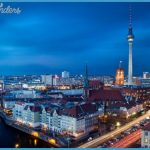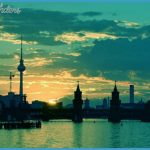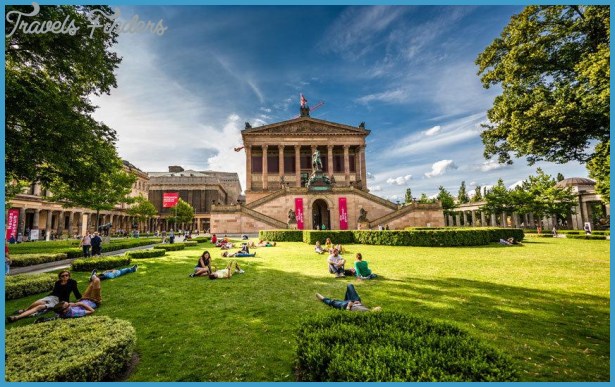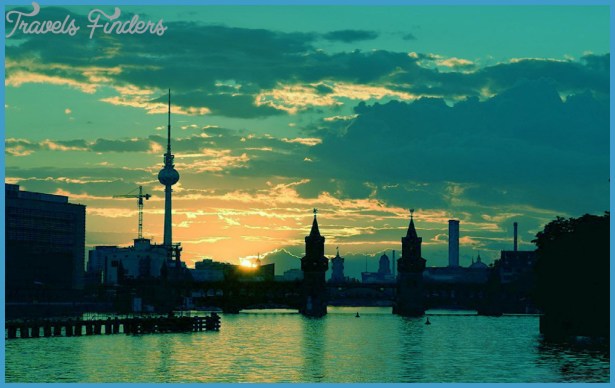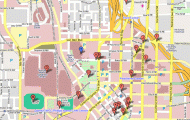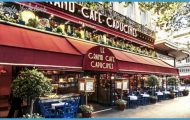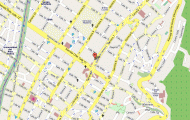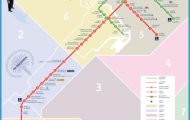Berlin Travel Destinations
UNTER DEN LINDEN
Unter den Linden is one of the best known boulevards in Europe and the spine of Imperial Berlin. During the Cold War it was known as the idiot’s mile because it was often all that visitors to the East saw, giving them little idea of what the city was really like. Beginning in Pariser Platz in front of Brandenburger Tor, the street runs east through Bebelplatz and the Lustgarten, interspersed with huge dramatic squares. (SI: Unter den Linden. Bus #100 mns the length of the boulevard every 4S minutes.)
BRANDENBURGER TOR. Built during the reign of Friedrich Wilhelm II as an image of peace to replace its medieval predecessor, the gate became the enduring symbol of the Cold War East-West division. Situated directly in the center of the city, it was the heart of no-man’s land for decades. Today the Brandenburg Gate is the most powerful emblem of reunited Germany and Berlin. The Room of Silence in the northern end of the gate provides a place for meditation and reflection.
RUSSIAN EMBASSY. Rebuilding the edifices of the rich and famous wasn’t a huge priority in the workers’ state. One exception was this massive structure, which covers almost an entire block. While the palace reverted to being just another embassy at the end of the Cold War, you can still marvel at the imposing building from behind the iron fencing. (Unter den Linden 55.)
DEUTSCHE STAATSBIBILIOTHEK AND HUMBOLDT-UNIVERSITAT. The stately library’s shady, ivy-covered courtyard, accentuated by serenely lounging intellectuals, provides a pleasant respite from the surrounding urban bustle. (Unter den Linden 8. Open M-F 9am-9pm, Sa 9am-5pm. ‚0.50. Free Internet.) Just beyond the Staatsbibliothek lies Humboldt University, which saw the likes of Hegel, Einstein, the Brothers Grimm, Bismarck, and Karl Marx. In the wake of the post-1989 shift, in which tainted departments were radically revamped or simply shut down, international scholars have descended upon the university to take part in its dynamic renewal. (Unter den Linden 6.)
NEUE WACHE. The New Guardhouse was designed by Prussian architect Karl Friedrich Schinkel in unrepentant Neoclassical style. During the DDR era, it was known as the Memorial to the Victims of Fascism and Militarism, and, ironically, was guarded by East German soldiers. It was reopened in 1993 as a war memorial. The remains of an unknown soldier and an unknown concentration camp victim are buried inside with earth from Nazi concentration camps as well as dirt from the Stalingrad battlefield. (Unter den Linden 4. Open daily 10am-6pm.)
BEBELPLATZ. On May 10,1933 Nazi students burned nearly 20,000 books here by subversive authors such as Heinrich Heine and Sigmund Freud both Jews. A plaque in the center of the square is engraved with Heine’s eerily prescient 1820 quote: Nur dort wo man Bucher verbrennt, verbrennt man am Ende auch Menschen. (Wherever books are burned, ultimately people are burned as well.)
The building with the curved facade is the Alte Bibliothek, which was once the royal library. On the other side of the square is the Deutsche Staatsoper, one of Berlin’s three operas, fully rebuilt after the war from original sketches. The distinctive blue dome at the end of the square belongs to the St.-Hedwigs-Kathedrale. Completed in 1773 as Berlin’s first Catholic church built after the Reformation, it was destroyed by American bombs in 1943 and rebuilt in the 1950s. (Cathedral open M-Sa 10am-5pm, Su l-5pm. Free. Organ concerts Wat 3pm.)


